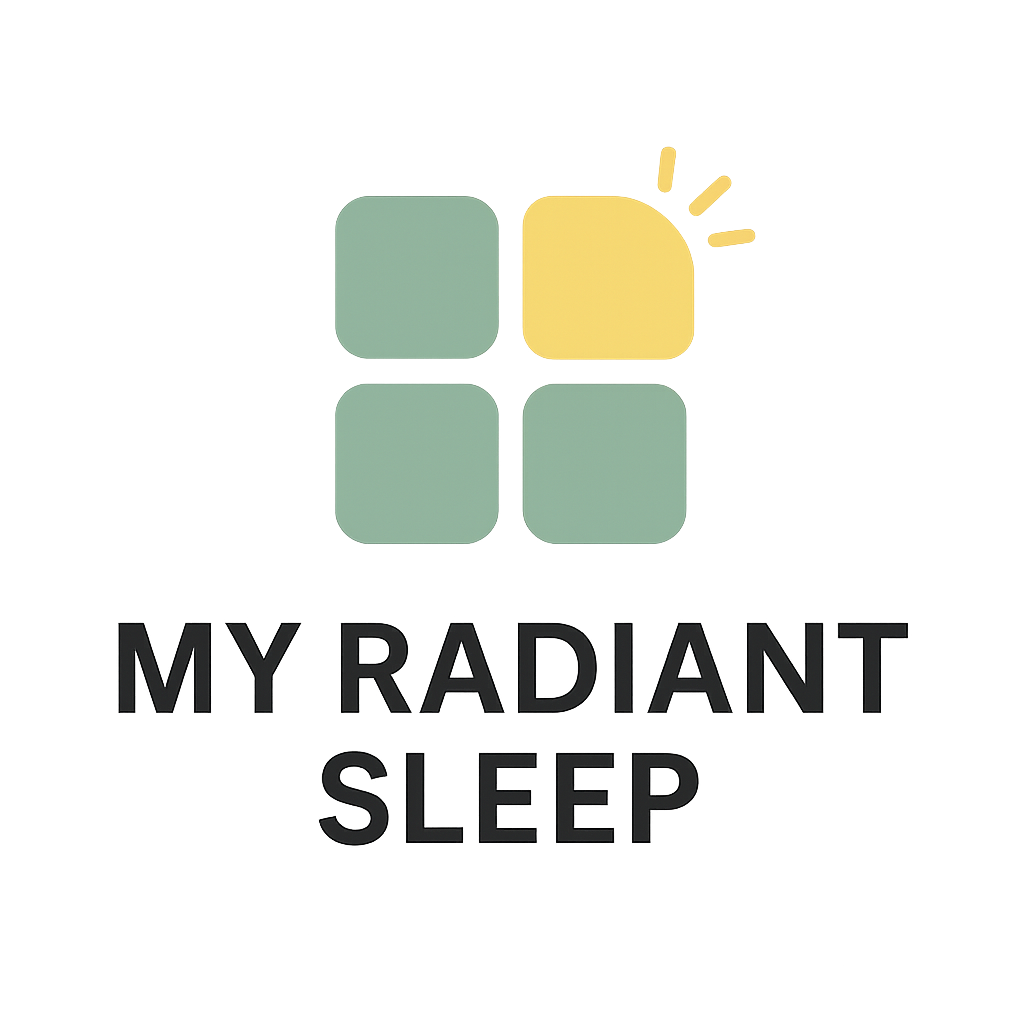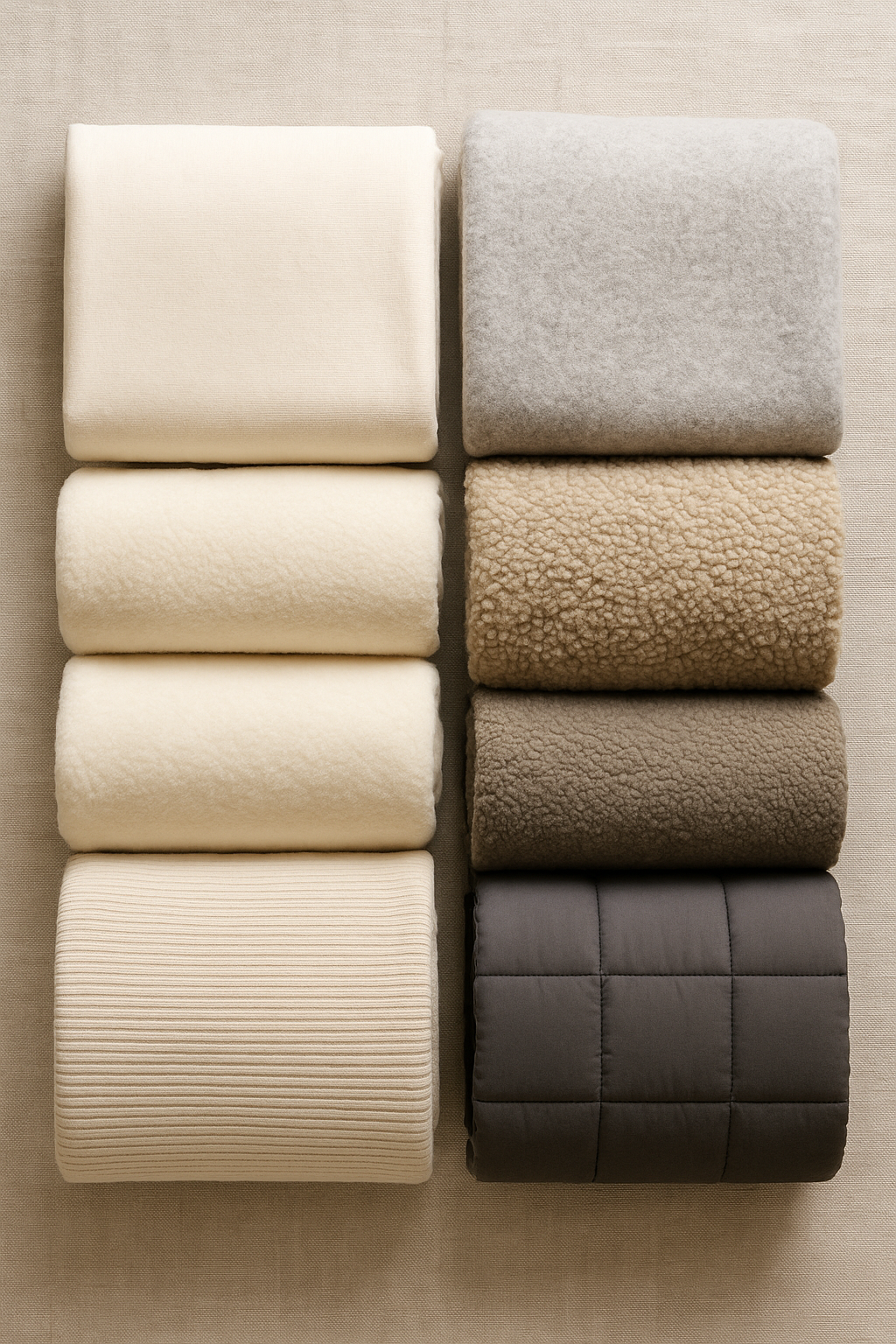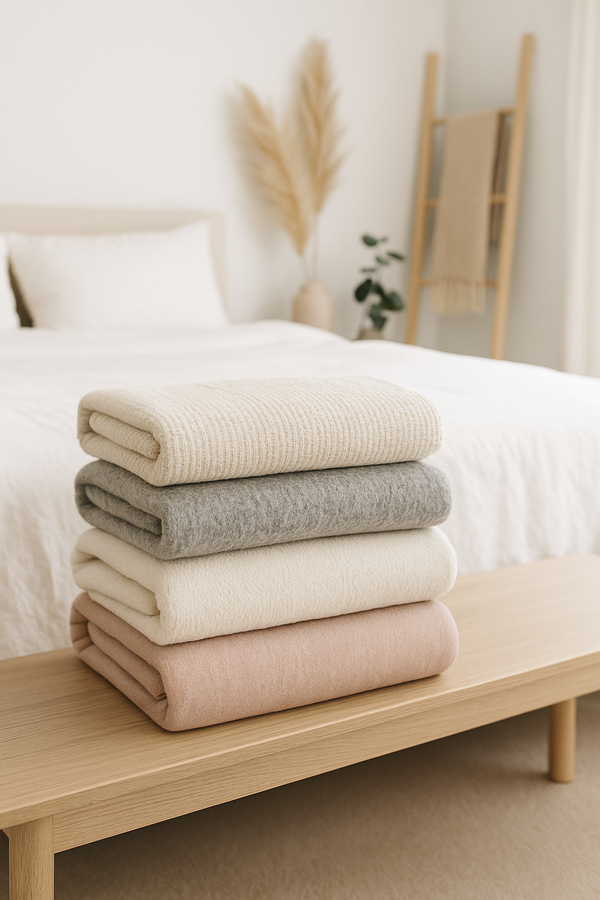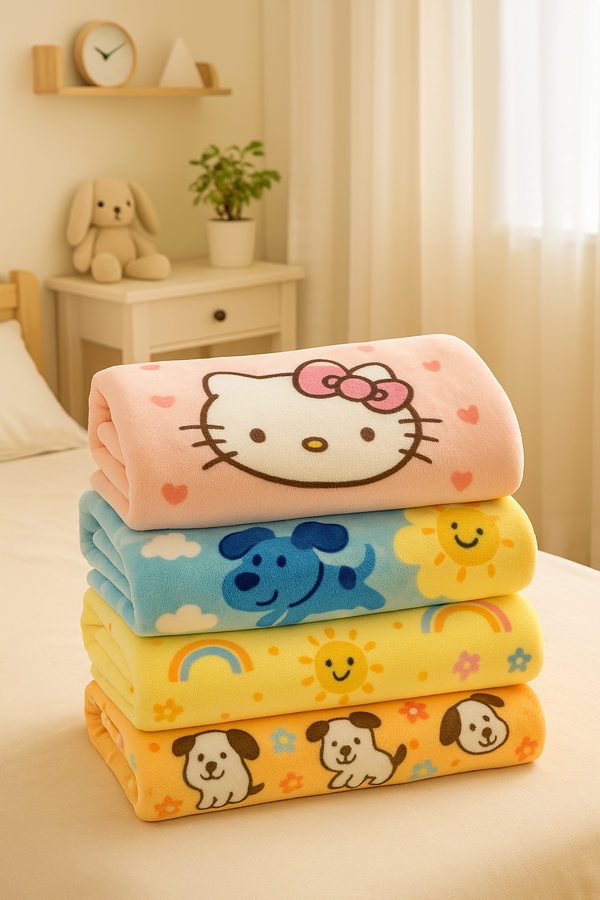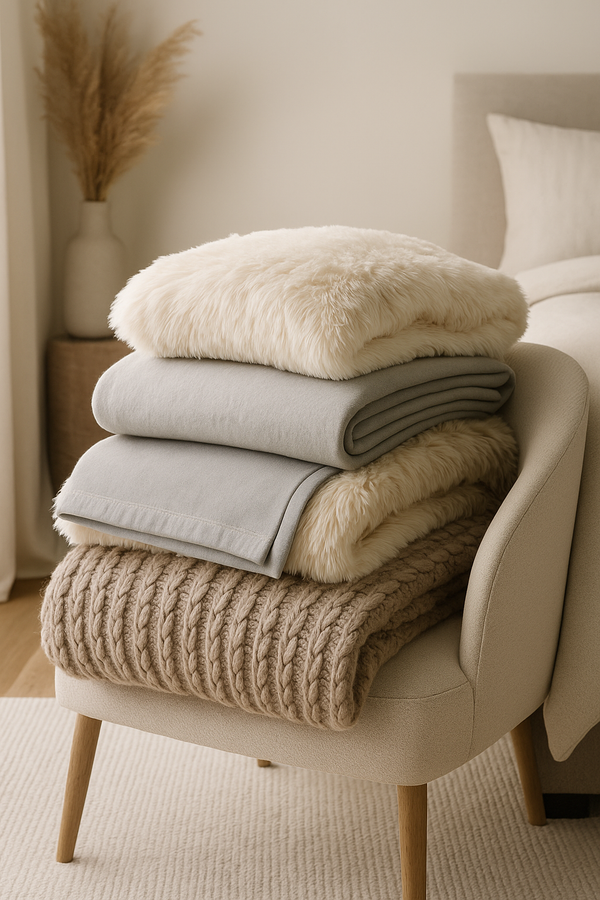Blankets have evolved far beyond simple layers of warmth — they’ve become a centerpiece of comfort, design, and personal expression in every modern home.
Whether you’re curling up on the couch, layering a soft throw across your bed, or searching for a breathable blanket for summer nights, the right one can instantly elevate how you rest, relax, and recharge.
In 2025, choosing the perfect blanket means understanding more than just looks and price. You’ll find dozens of blanket types — from cozy fleece and cotton weaves to advanced cooling and weighted options — each designed for different seasons, climates, and comfort preferences. Materials, sizing, and maintenance all play major roles in long-term comfort and durability.
This guide simplifies it all. Below, we’ll explore the most popular blanket types, materials, and sizes, along with smart buying tips, care techniques, and insights into today’s best brands and retailers.
Whether you’re shopping for your first luxury throw or upgrading everyday essentials, this ultimate blanket guide helps you find the ideal match for your lifestyle and sleep needs.
🌿 Why Blankets Matter More Than Ever (2025 Trends)
Blankets have always been linked to rest and wellbeing. Today they also reflect lifestyle and design trends:
- Comfort culture: soft textures and “cocooning” fabrics dominate modern homes.
- Sustainability: eco-fibres like bamboo and organic cotton are replacing synthetics.
- Technology: innovations such as temperature-adaptive or moisture-wicking materials redefine comfort.
From luxury wool throws to affordable microfibre layers, every blanket has a purpose. The key is matching your lifestyle, sleep style, and space.

🛏️ The Main Types of Blankets (and the Materials That Define Them)
Blankets come in countless forms—each crafted for different levels of warmth, texture, and style. The best material for you depends on how you sleep, your home’s temperature, and your bedroom decor. Some are lightweight and breathable; others provide insulation for colder months or decorative flair year-round.
Cotton Blankets: Natural Comfort and Everyday Versatility
Cotton is among the best materials for blankets thanks to its softness, breathability, and durability. A high-quality cotton blanket made from finely woven cotton fabric works well in any season and pairs beautifully with a duvet cover for layering. Cotton blankets are also easy to wash, making them an affordable option for families seeking comfort that lasts.
Wool and Sherpa Blankets: Warmth for Cold Nights
Wool and sherpa blankets deliver luxurious warmth during cold nights and winter months. Wool naturally repels moisture and regulates temperature, while sherpa’s plush, fuzzy surface mimics real fleece for a cosy feel. Many premium wool options blend in other materials like cashmere or alpaca for a softer texture.

Fleece, Polar Fleece, and Microfibre Blankets
Fleece and polar fleece blankets are known for softness, lightweight feel, and quick-dry performance. A microfiber blanket made from finely spun synthetic material is both wrinkle-resistant and durable, ideal for children’s rooms or outdoor lounging. These blankets are a practical, low-maintenance choice that still feels luxuriously soft against the skin.
Weighted Blankets: Calming and Supportive Pressure
Weighted blankets contain plastic pellets or glass beads that are evenly distributed throughout to provide gentle, consistent pressure.
This “deep-touch” effect can reduce stress and improve sleep quality by relaxing the nervous system. Weighted options are particularly helpful for people managing anxiety, insomnia, or mild sleep apnea symptoms, offering both comfort and stability at night.

Heated (Electric) Blankets: Technology Meets Comfort
Modern heated blankets use integrated electrical heating wires hidden between soft layers to provide consistent warmth.
They’re perfect for colder months, adjustable for personal comfort, and can even add an extra layer of heat beneath a comforter. Always follow safety instructions and avoid folding them tightly when stored.
Outdoor and Travel Blankets: Comfort Beyond the Bedroom
Designed for outdoor use, travel blankets and sleeping bag-style throws feature water-resistant shells, durable stitching, and easy-pack portability. Some models—such as Vellux blankets—combine fleece-like softness with incredible resilience, making them excellent for camping trips or movie nights under the stars.

💰 Category Breakdown by Price & Focus
Once you understand the materials and types of blankets, the next step is choosing the right one for your budget and lifestyle. Blankets now come in every imaginable tier—from under $20 everyday options to luxury organic weaves that rival fine bedding.
Many bedding sets include comforters and blankets made from a variety of materials and thicknesses to suit different preferences and climates. The price you pay often reflects not only fabric quality but also ethical sourcing, temperature regulation, and design aesthetics.
Whether you’re shopping at Amazon, Walmart, Target, or a specialty home retailer, use this chart as your quick reference to compare material focus, brand category, and overall value.
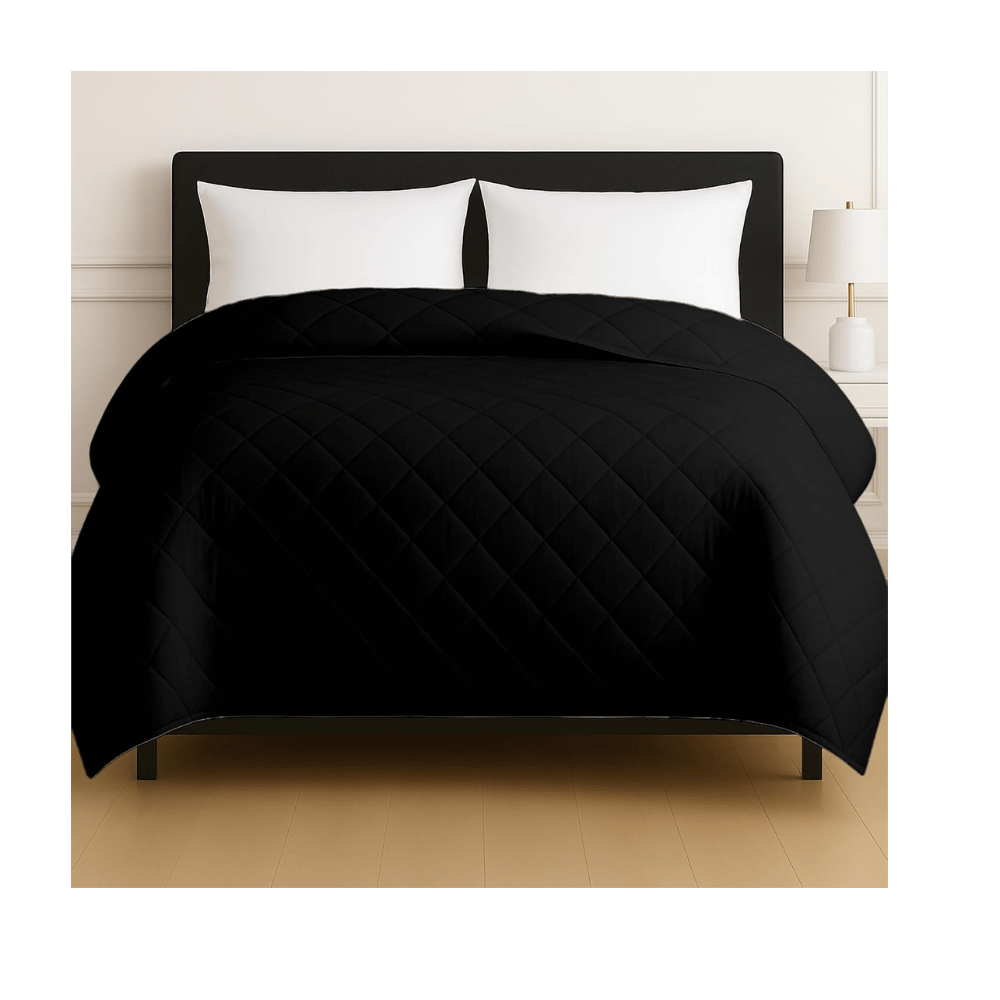
Category | Typical Price Range | Representative Brands | Material Focus | Best Retailers (2025) |
🩶 Budget Everyday Comfort | $13–$35 | Bedsure, Utopia Bedding, BEDELITE, LOMAO | Fleece, microfiber, sherpa | Amazon, Walmart |
🌤️ Decorative & Trendy Throws | $30–$60 | Cozy Bliss, Snuggle Sac, BENVWE, WRNESONGE, Bigacogo | Faux fur, knit, chenille, bubble textures | Amazon, Target, Wayfair |
💎 Luxury & Premium Comfort | $90–$170 | UGG, Evergrace, Touchat, Cozy Earth | Plush fleece, reversible faux fur, oversized throws | Amazon, Bloomingdale’s, Nordstrom |
🌿 Eco & Natural Fabrics | $60–$130 | Threadmill, Cloud Scape, Boll & Branch, Alpaca Home | Cotton, linen, wool, bamboo | Amazon, Boll & Branch, Target |
⚙️ Functional Tech & Weighted | $40–$230 | Beautyrest, HomeSmart, REST, YesCool | Weighted, heated, cooling designs | Amazon, Walmart, Sleep Number |
💫 Ultra-Luxury / Designer Blankets | $200+ | Boll & Branch, Vesta, Barefoot Dreams | Organic cotton, silk, high-end weaves | Nordstrom, Pottery Barn, brand stores |
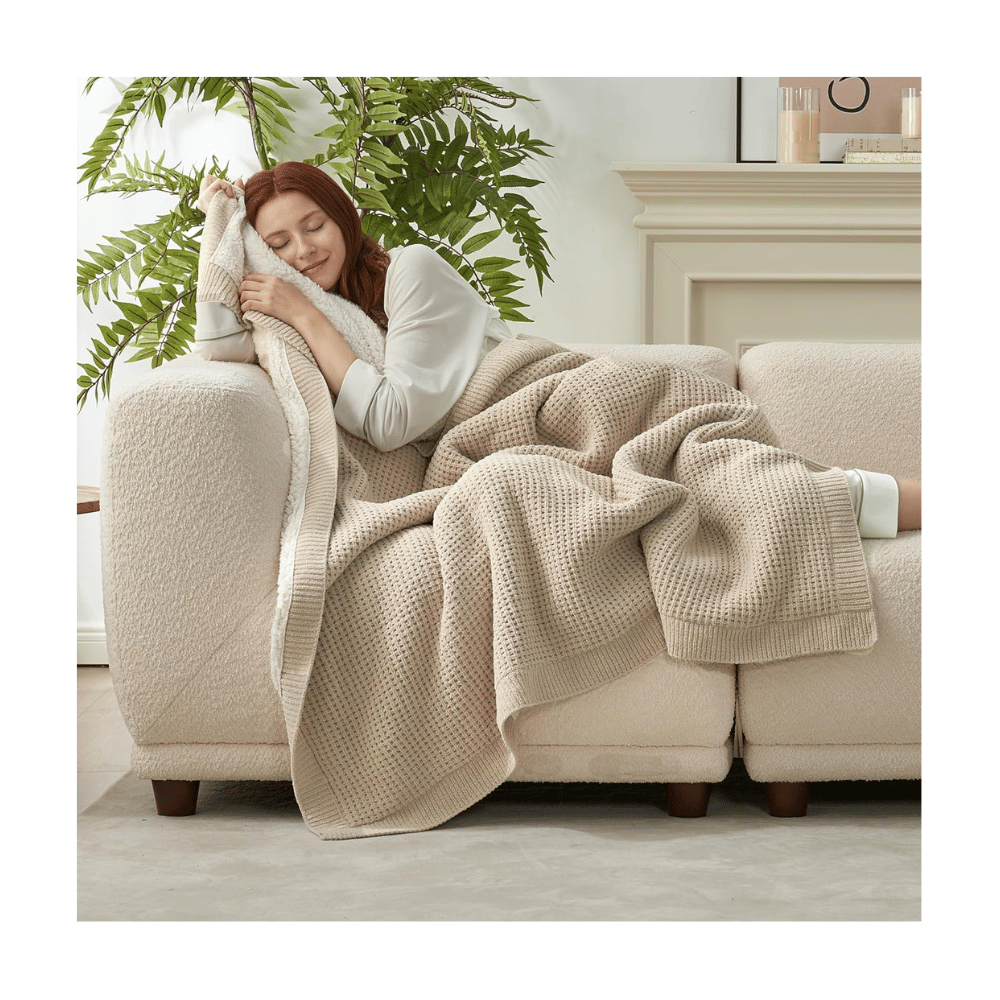
🪶 Understanding Each Category
In today’s blanket market, each price tier serves a distinct purpose. Personal preference plays a major role in selecting the right blanket category for comfort and style.
Budget blankets have become impressively soft and functional, while midrange decorative throws add personality and layering options to your space. Luxury and eco-friendly categories now merge comfort with sustainability, and functional tech blankets are transforming how we experience warmth year-round.
— See our recommendations for the best Western bedding options for comfort and style.
Here’s a quick guide to what each level delivers in real-world comfort and performance:

🩶 Budget Everyday Comfort
If you’re looking for softness and practicality on a budget, this tier is the perfect match.
- Lightweight fleece and microfiber are warm, durable, and machine washable.
- Ideal for guest rooms, dorms, or casual living room layers.
- Often features sherpa reversibles or simple stitched borders for a clean, cozy look.
🪄 Tip: Look for “anti-pill” or “fade-resistant” in product descriptions to ensure long-term quality.

🌤️ Decorative & Trendy Throws
“These blankets blur the line between comfort and décor. Many decorative throws are easily thrown over beds or sofas, serving as accent pieces that enhance both warmth and aesthetic appeal. Texture, color, and design take center stage.”
- Knit, faux fur, or chenille constructions that double as statement pieces.
- Common in bold patterns or neutral palettes for easy styling.
- Ideal for draping over sofas, accent chairs, or as a foot-of-bed layer.
They bring personality to your home—proof that warmth can be stylish too.
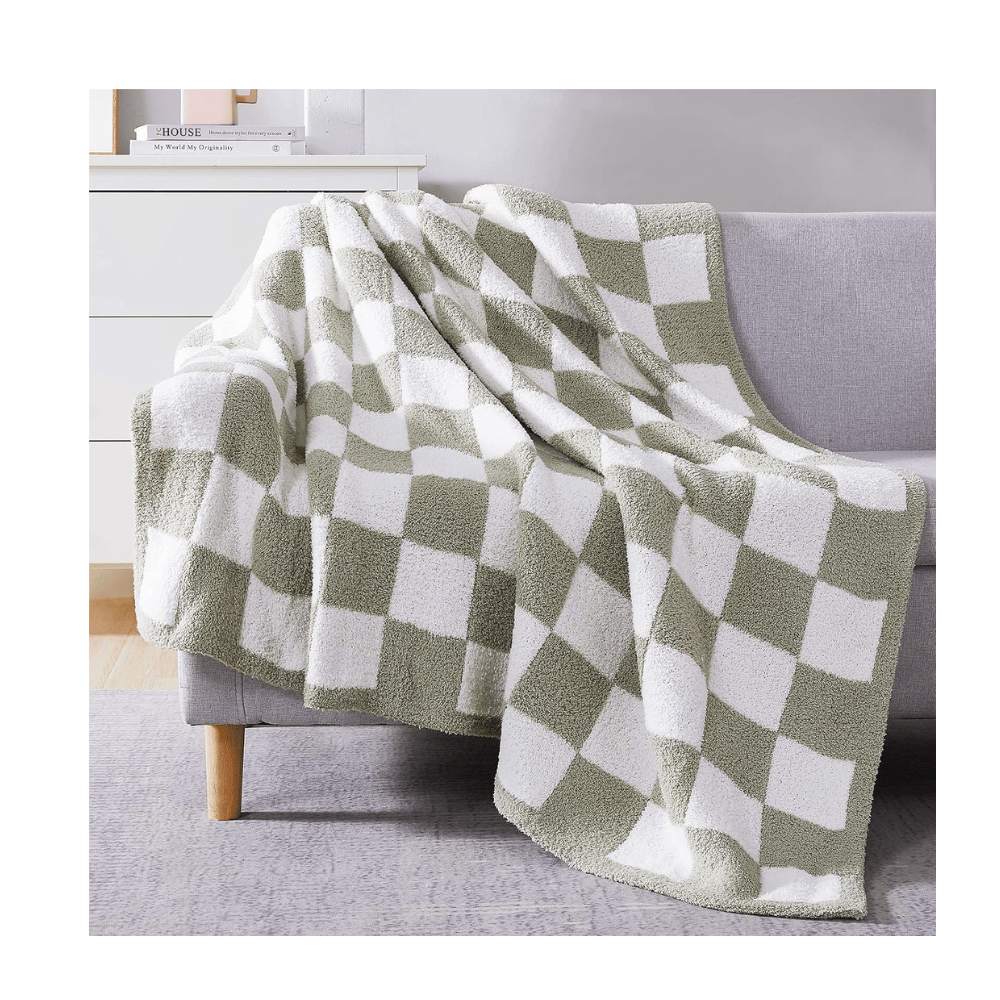
💎 Luxury & Premium Comfort
When comfort meets craftsmanship, you enter the luxury tier. These blankets are investment pieces designed to last years.
- Reversible faux fur and premium fleece provide silky softness and substantial weight.
- Superior stitching, edge binding, and fabric density reduce shedding and wear.
- Brands often include gift-ready packaging or monogram options for personalization.
Expect a noticeable upgrade in feel, durability, and aesthetic presence when you choose the best mattress for your guest room.
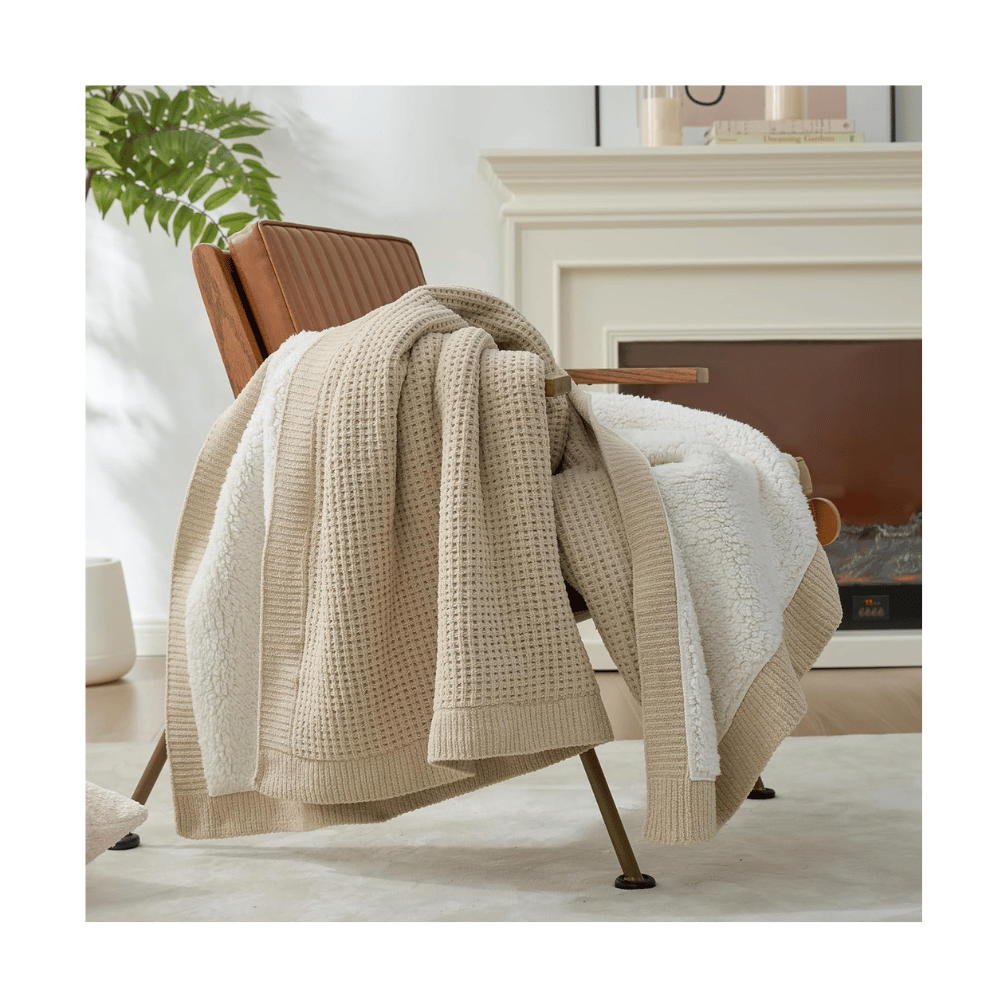
🌿 Eco & Natural Fabrics
Eco-conscious buyers continue to drive demand for sustainable blankets that feel as good as they are responsible.
- Organic cotton, linen, bamboo, and wool are the hallmarks of this category.
- Naturally breathable, moisture-wicking, and biodegradable.
- Often produced with ethical labor standards and certifications like OEKO-TEX® or GOTS.
You’ll pay slightly more, but you’ll enjoy healthier materials and timeless comfort.

⚙️ Functional Tech & Weighted
For sleepers who love innovation, this is where technology meets coziness.
- Weighted blankets simulate gentle pressure to relieve anxiety and enhance sleep.
- Heated models include adjustable thermostats and safety timers.
- Cooling blankets use phase-change fabrics or gel infusions to keep hot sleepers cool.
Perfect for year-round use, these designs adapt to both your temperature and comfort preferences.
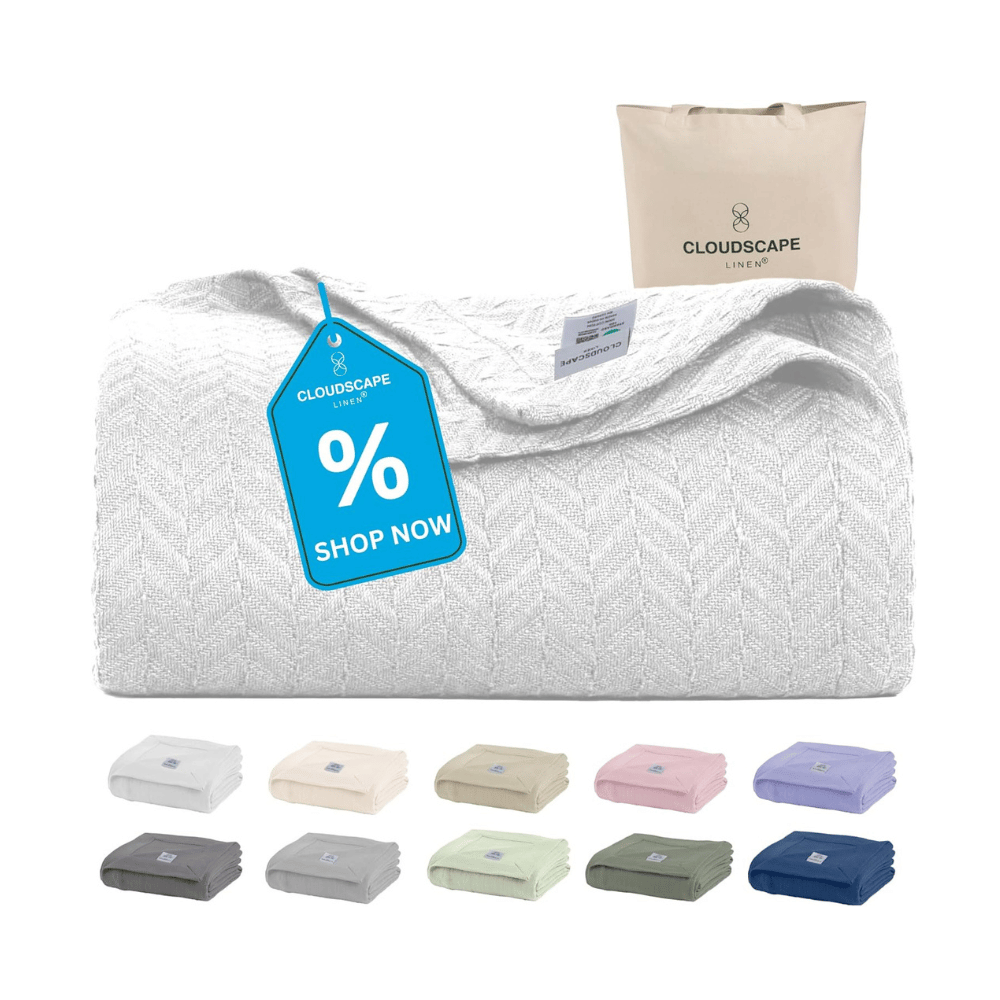
💫 Ultra-Luxury / Designer Blankets
At the top of the blanket hierarchy, ultra-luxury pieces combine art, craft, and sensory indulgence.
- Crafted from organic cotton, silk, or alpaca blends.
- Found in limited-edition designs with premium stitching and edge finishing.
- Often made by heritage brands or small luxury ateliers.
These blankets double as décor and heirlooms—ideal for primary bedrooms, lounges, or gifting.

🧠 Key Takeaway
The right blanket category depends on your lifestyle:
- Families may prioritize budget and washable options.
- Design enthusiasts gravitate toward decorative and luxury throws.
- Eco-minded shoppers appreciate sustainable natural fibers.
- Tech-savvy sleepers value weighted or heated innovations.
- Sleeping habits, such as a preference for extra warmth or a cooler feel at night, also play a key role in selecting the right blanket.
By understanding what each tier delivers, you can confidently balance price, comfort, and long-term value while curating a collection that feels both practical and personal.

📏 Blanket Sizes and Dimensions Chart
Choosing the right blanket size is just as important as selecting the right material. A blanket that’s too small won’t offer full coverage, while one that’s oversized can overwhelm your bed or sofa. The perfect fit depends on your bed size, room proportions, and how you plan to use the blanket—whether for sleeping, layering, or décor. Choosing the right blanket size can also enhance your overall bedroom design by ensuring your bedding complements the style and proportions of your space.
Below is a quick reference chart to help you find the ideal dimensions before you buy.
🪶 Standard Blanket Sizes
Blanket Type | Dimensions (inches) | Best For |
Throw Blanket | 50 × 60 in (approx.) | Couch, chair, travel, or decorative use |
Twin Blanket | 66 × 90 in | Twin or Twin XL beds, single sleepers |
Full / Double Blanket | 80 × 90 in | Full beds or shared use for smaller frames |
Queen Blanket | 90 × 90 in – 90 × 100 in | Most households; balanced warmth and coverage |
King Blanket | 108 × 90 in – 110 × 100 in | Couples, king-size beds, or layered luxury |
California King | 112 × 100 in (approx.) | Extra-long beds and oversized comfort |
Weighted Blanket | Varies (typically 48 × 72 in to 80 × 87 in) | Tailored to body weight – about 10–12 % of your weight |

🧺 Choosing the Correct Blanket Size
Most shoppers assume blanket size equals mattress size, but that’s not always true. Because blankets drape and move, a few extra inches make all the difference.
Key tips to keep in mind:
- Always measure your bed before buying, especially if you use deep mattresses or thick toppers.
- For a clean hotel-style look, allow 8–10 inches of drop on each side.
- Queen and king blankets often double as cozy throws for larger sectionals or movie nights.
- Weighted blankets should match your body size—not the bed size—for optimal pressure distribution.
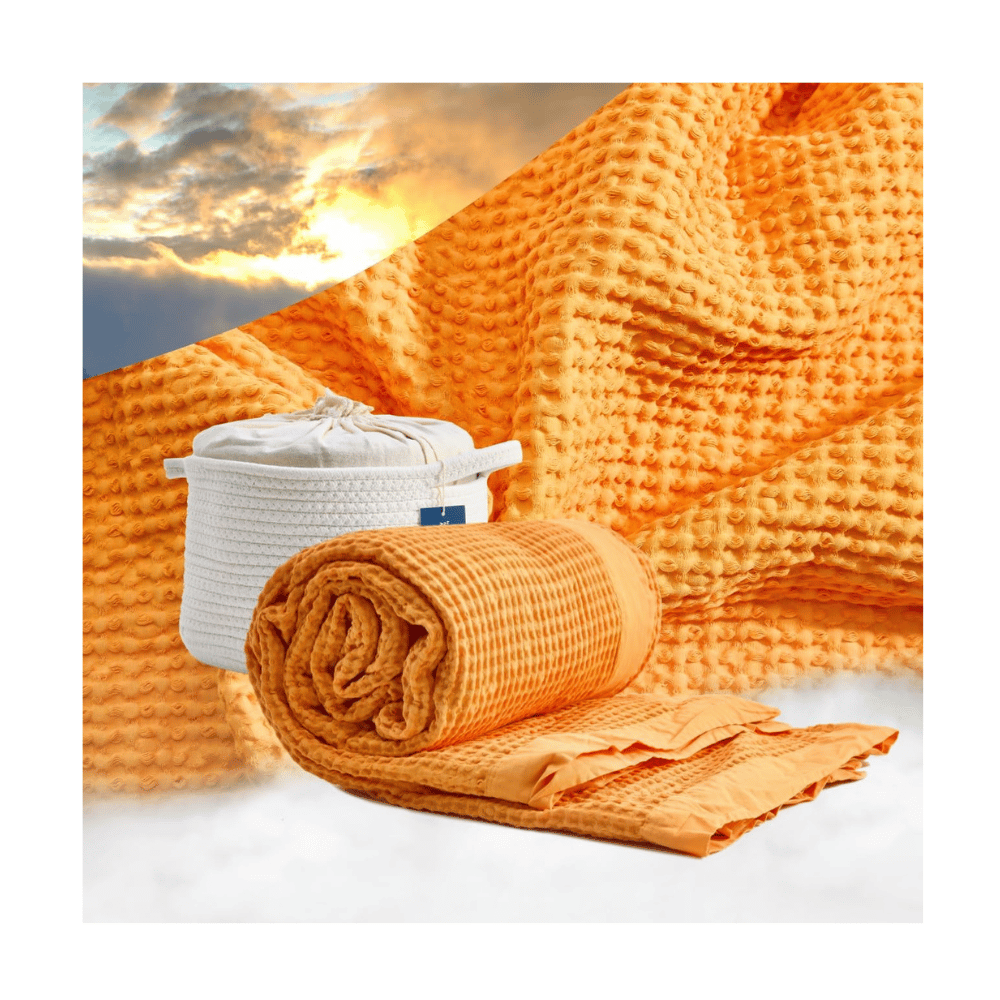
🌤️ Blanket Layering Made Easy
Blanket sizing also affects how your bedding layers look and feel. When layering:
- Start with a light cotton or linen blanket for breathability.
- Add a fleece or wool mid-layer for warmth.
- Finish with a decorative throw folded at the foot of the bed for color and texture.
This combination keeps your sleep setup comfortable year-round.
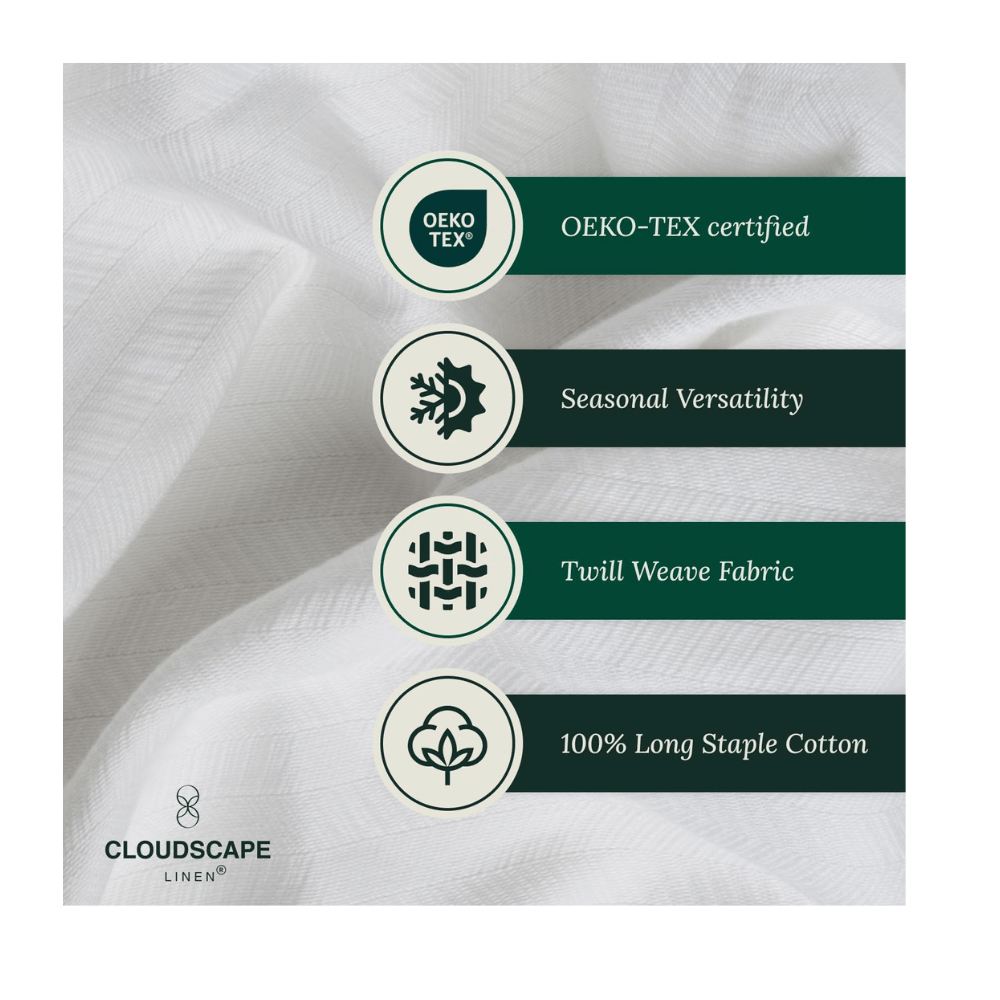
🏡 How to Choose the Right Blanket for Your Home
Choosing the right blanket means balancing warmth, comfort, and lifestyle. Whether you want a plush wool throw or a wrinkle-resistant microfiber blanket, the goal is to find a piece that enhances both your sleep and your space.
1. Match the Blanket to the Room and Use
Think about where and how the blanket will live. In bedrooms, soft cotton or bamboo provides breathable comfort that complements your bedroom décor, while a sherpa blanket or fleece throw adds texture and depth for winter. For guest rooms or kids’ spaces, an affordable option made from sturdy synthetic materials is ideal for easy washing and long-term use.
2. Consider Climate and Season
For colder months, wool, fleece, or dual-layer cotton-blend blankets add an extra layer of insulation. In warmer climates, light cotton or bamboo keeps airflow steady. A duvet cover over a thin blanket can also adjust warmth through the year.

3. Focus on Materials and Sleep Needs
Different materials support different comfort levels.
- Cotton and linen improve breathability.
- Fleece and polar fleece enhance warmth without heaviness.
- Weighted blankets with evenly distributed filling aid relaxation and boost sleep quality.
If you have sleep apnea or prefer cooler sleeping temperatures, a breathable blanket helps reduce overheating while maintaining softness.
4. Look for Additional Features
Blankets now offer innovative additional features such as dual-zone heating, moisture-wicking fibres, or integrated electrical heating wires for consistent warmth. Even Vellux blankets, known for resilience, are now designed with softer edges and fade-resistant finishes.
5. Durability and Value
An investment blanket doesn’t have to be expensive—choose one built from synthetic materials or blended cotton fabrics for daily use, or natural wool for long-term comfort. Always review stitching, edge finishes, and ease of washing to ensure your blanket stays plush through countless washes.

☀️ Seasonal and Lifestyle Recommendations
Blankets are deeply personal — what feels soft and inviting to one person may feel too heavy or warm to another. In 2025, the variety of options makes it easy to find a cozy blanket that matches your comfort level, sleep habits, and bedroom décor. This section helps you select the ideal blanket type and material for every season and situation.
❄️ Winter Warmth and Cold Climates
As temperatures fall, your blanket becomes more than decoration — it’s an everyday essential offering warmth and natural insulation for cool nights. The goal is to retain body heat while allowing subtle airflow for comfort.
Wool, fleece, and sherpa-lined designs remain favorites for their ability to provide warmth without excess bulk. For style and practicality, layer a faux-fur throw over a cotton base blanket. Weighted blankets perform beautifully in winter, evenly distributing pressure to calm the body and promote relaxation.
Pro Tip: Blankets blending natural fibres with synthetic fibres maintain softness and warmth longer, perfect for families or anyone who wants comfort that lasts through colder months.
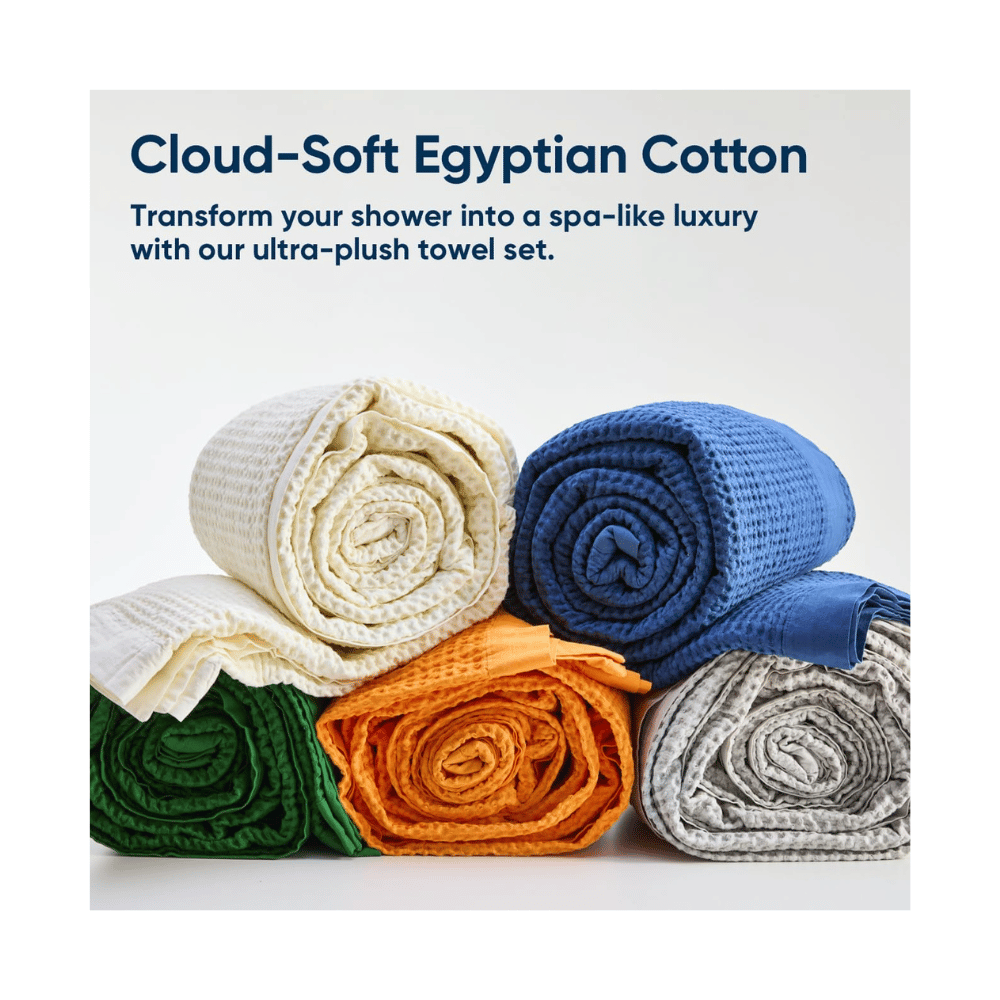
🌤️ Summer and Warm Climates
During warmer weather, comfort depends on breathability and temperature control. Those who sleep hot should choose materials like cotton, linen, or bamboo that wick away moisture and balance body heat throughout the night.
Cotton waffle and bamboo blankets create micro air pockets that keep you cool yet cozy. In humid regions, lightweight synthetic fibres such as microfiber improve airflow and dry quickly after washing.
Quick Tips:
- Stick to single-layer weaves rather than thick knits.
- Avoid dense polyester blends that trap heat.
- Choose pale colours that reflect light for a fresher look and feel.

🧸 Families, Kids, and Everyday Use
Households with children or pets need reliable comfort that’s easy to clean and long-lasting. Blankets made with synthetic fibres like polar fleece or microfiber offer great durability while staying soft and machine washable.
For babies and toddlers, muslin or bamboo baby blankets reduce overheating and stay gentle on sensitive skin. Teens love lightweight throws for lounging or watching TV, while adults appreciate versatile designs that elevate a sofa or guest bed instantly.
Family-Friendly Checklist:
- Machine washable on warm cycles.
- Fade-resistant colours.
- Reinforced stitching for daily use.
- Hypoallergenic fabrics for sensitive skin.
A small rotation of soft, durable blankets keeps your home inviting year-round — a mix of practicality, style, and comfort offering warmth for every season.
🩵 Key Takeaway
Your perfect blanket changes with the season, your habits, and even your mood.
- Winter: heavier fleece and wool layers.
- Summer: breathable cotton or bamboo.
- Families: easy-care synthetics or muslin.
- Travel: lightweight, foldable performance fabrics.

🧺 Blanket Care, Maintenance & Longevity Tips
Even the most luxurious blanket loses its appeal if it’s not properly cared for. Regular cleaning, correct storage, and gentle maintenance extend both the life and comfort of your favorite blankets. Each material has its own needs, but a few universal habits will keep every piece soft, fresh, and ready for use.
🧵 1. Read the Label Before You Wash
Before tossing any blanket into the machine, always check the care tag. Each fiber reacts differently to heat, moisture, and detergents. Woven fabric blankets, such as quilts or accent pieces, may require special care to maintain their structure and appearance. Cotton, fleece, and microfiber typically tolerate warm cycles, but wool, silk, and electric blankets demand special attention.
General washing guidelines:
- Cotton, fleece, microfiber: machine wash on gentle with mild detergent.
- Wool and cashmere: handwash or dry-clean to prevent shrinkage.
- Heated or electric blankets: unplug first, use the delicate cycle, and air-dry.
🪄 Pro tip: Skip fabric softeners when possible—they coat fibers and reduce absorbency over time.
🌤️ 2. Drying and Freshening Your Blankets
How you dry your blanket matters just as much as how you wash it. High heat can weaken fibers or alter the texture, especially in plush or blended fabrics.
When possible, air-dry blankets outdoors or in a low-heat tumble setting. The sun naturally sanitizes and removes odors, while low dryer heat maintains softness. You can also refresh blankets between washes by lightly misting them with linen spray or hanging them in a breezy area.
🪶 3. Seasonal Storage Tips
Proper storage keeps blankets fresh and prevents damage during the off-season. Clean your blankets before storing them — oils and debris left on fabric can attract pests or cause discoloration.
Fold each blanket neatly and store it in a cotton or linen storage bag that allows airflow. Avoid plastic bins, which trap moisture and cause musty odors. For valuable wool or luxury blankets, add cedar blocks or lavender sachets to deter moths naturally.
Storage tips at a glance:
- Store in cool, dry spaces away from direct sunlight.
- Roll thick blankets to prevent creases.
- Label storage bags for easy rotation by season.
♻️ 4. Extending Longevity Through Rotation
Blankets, like bedding, benefit from rotation. Switching between a few favorites prevents excessive wear and helps maintain texture. For example, alternating between a cotton layer and a plush fleece keeps both in better shape.
If your blanket begins to feel rough or dull, try a vinegar rinse cycle (½ cup white vinegar) to restore softness naturally. For pilling on fleece or knit designs, use a fabric shaver or lint comb to gently revive the surface.
🩵 Regular small maintenance steps can add years of life to your favorite blanket.
🎨 Expert Tips for Styling Blankets in Any Room
A blanket isn’t just a comfort essential — it’s one of the easiest ways to elevate the style and mood of a space. Decorative blankets are often used to add visual interest and personality to any room.
The right fold, texture, or placement can transform a plain bed or sofa into a designer-worthy focal point. Whether you prefer minimal, rustic, or cozy-chic interiors, a few simple techniques can make your blankets look effortlessly curated.
🛏️ 1. Layer with Intention
Blanket layering adds instant visual depth and warmth to your bed setup. Start with a lightweight base blanket for function, then add a decorative throw or textured top layer for style. Keep the heaviest piece at the foot of the bed for balance.
Try this simple formula:
- Base layer: soft cotton or linen blanket for structure.
- Middle layer: quilt or fleece for warmth.
- Top accent: a knitted, faux-fur, or fringe throw for color contrast.
Neutral tones create calm sophistication, while bold patterns introduce personality. Fold neatly for a tailored look, or drape casually for relaxed charm.
🛋️ 2. Add Warmth to Living Spaces
Consider adding a Twin XL mattress to your living space for extra comfort and warmth, especially in dorms or compact rooms.
In living rooms, blankets can define a style story while keeping you cozy. Drape one diagonally across a sofa arm, stack two on an ottoman, or roll several into a woven basket beside a chair for texture. The key is purposeful imperfection — it should look inviting, not staged.
To highlight your blanket’s design:
- Let textured fabrics contrast against smooth upholstery.
- Use complementary tones (e.g., cream on gray, camel on navy).
- Anchor throws with matching or tonal cushions for cohesion.
🪄 Designer tip: Pair blankets with natural materials like rattan, wood, or linen curtains to create a warm, organic feel.
🪶 3. Rotate Seasonally
Styling changes with the seasons. Light, airy cottons and linens suit spring and summer; plush fleece or wool blankets add cozy drama in fall and winter. Rotating not only keeps your décor fresh but also extends the lifespan of your blanket through gentler use.
Consider storing out-of-season blankets in decorative bins or baskets — they’ll stay accessible and become part of your room’s texture story.
🌙 My Final Thoughts
A great blanket isn’t just something you sleep under—it’s something you live with. From breathable cotton for summer nights to plush wool or sherpa for winter, each material brings its own rhythm of comfort and style. Choosing wisely means looking beyond price or color to consider how it feels, performs, and fits the flow of your life.
The goal of this 2025 blanket guide has been to simplify that decision—to show that warmth, texture, and durability can coexist beautifully.
Whether you prefer natural fabrics, tech-infused designs, or luxury throws that double as décor, the best blanket is the one that quietly supports your rest and restores your peace of mind.
FAQs
What is the thickest type of blanket?
The thickest types of blankets are usually comforters or quilts. They feature multiple top and bottom layers or dense weaves for maximum insulation. Comforters are typically made from two lengths of fabric sewn together and filled with insulating materials such as down, feathers, or synthetic fibers.
Are there different types of blankets?
Yes. Blankets come in many varieties, each suited for specific seasons and preferences. Common types include fleece, cotton, wool, weighted, heated, and throw blankets. Fleece and microfiber provide plush warmth, while cotton and linen are more breathable for warmer months. Weighted and electric blankets cater to specialized comfort or therapeutic needs. Quilts are another popular type, and they are constructed with three layers: a top layer, a middle insulating layer, and a bottom backing.
What do you call a fuzzy blanket?
A fuzzy blanket usually refers to fleece, sherpa, or faux-fur blankets—materials known for their soft, fluffy texture. They’re designed to retain warmth and offer a cozy, tactile experience that feels soothing against the skin.
What are thick blankets called?
Thick blankets are often called comforters, duvets, or heavy-knit throws. They feature multiple layers or dense weaves for maximum insulation. Some thick blankets are constructed with two layers of fabric for added insulation. Wool and faux-fur blankets also fall into this category, especially for cold-weather use.
What is a blanket with holes in it called?
Blankets with visible holes are known as crocheted or knitted blankets. The open-weave design creates decorative holes that enhance airflow, making them stylish and breathable for spring or layering. The weave method used in crocheted or knitted blankets determines the size and pattern of the holes.
